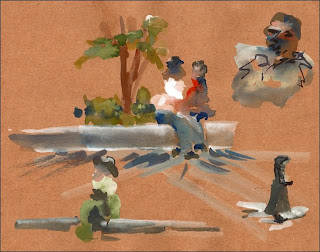
I had decided to convert my regular sketch kit from watercolors to gouache,
so I got out a small folding box with half pans and filled 'er up.
THAT didn't work at all. Since the box wasn't sealed, it was impossible to keep the paints in the open pans at a constant moisture. They just dried up, cracked apart, and went all over.
I don't want to carry whole tubes, so I decided to make a variation of
Jamie's great plein air kit.
I got one of those snap closure food storage boxes from the Container Store, about 8" x 5" x 2" deep. The kind that seals tightly with an 'O' ring.
Then I took a 6" x 4" x 1/4" piece of plexiglass and epoxied 10 of
those little paint cups onto the edges of that. Above is the plein air box, shown open, next to a 7x10 Arches paper block. The box on the left, the lid/palette on the right.
In the box on the left there is a folded piece of paper towel in the bottom. The plexi piece with the cups is on top. There is a small water bottle between the cups, a piece of damp sponge at the bottom, an extra paint cup, and a tube of white gouache. The brushes are on the side and the cut-down palette knife is in the middle.
I laminated a piece of paper (which I had printed a neutral gray) onto the outside of the lid. I am using the
inside of the lid as my palette, as you can see. The colors are much easier to deal with on that neutral gray background. (There is another rolled up piece of paper towel sitting at the top of the lid/palette.)
This is pretty handy, so far. If I can't keep the leftover paint on the inside of the lid from drying up and flaking off, I will have to clean the palette area off after each session. I am going to try to keep it moist by keeping that sliver of a sponge moist. We'll see.
The size is just right. The palette mixing area in the inside of the lid is a good size too. The only thing missing is one of those
big water containers. Which could be carried separately.
 This is on charcoal paper, done on the spot with pen+ink, then abused later with NuPastels and then with gouache.
This is on charcoal paper, done on the spot with pen+ink, then abused later with NuPastels and then with gouache.












